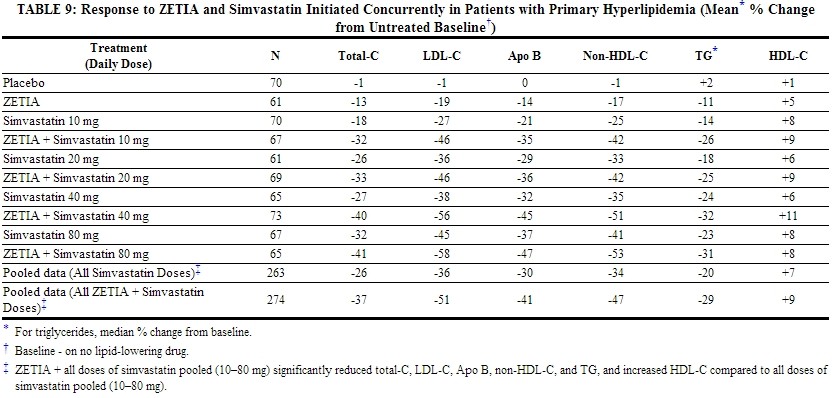Ezetimibe clinical studies
Editor-In-Chief: C. Michael Gibson, M.S., M.D. [1]; Associate Editor(s)-in-Chief: Sheng Shi, M.D. [2]
Clinical Studies
Primary Hyperlipidemia
ZETIA reduces total-C, LDL-C, Apo B, non-HDL-C, and TG, and increases HDL-C in patients with hyperlipidemia. Maximal to near maximal response is generally achieved within 2 weeks and maintained during chronic therapy.
Monotherapy
In two multicenter, double-blind, placebo-controlled, 12-week studies in 1719 patients with primary hyperlipidemia, ZETIA significantly lowered total-C, LDL-C, Apo B, non-HDL-C, and TG, and increased HDL-C compared to placebo (see Table 6). Reduction in LDL-C was consistent across age, sex, and baseline LDL-C.
 |
Combination with Statins
ZETIA Added to On-going Statin Therapy=
In a multicenter, double-blind, placebo-controlled, 8-week study, 769 patients with primary hyperlipidemia, known coronary heart disease or multiple cardiovascular risk factors who were already receiving statin monotherapy, but who had not met their NCEP ATP II target LDL-C goal were randomized to receive either ZETIA or placebo in addition to their on-going statin.
ZETIA, added to on-going statin therapy, significantly lowered total-C, LDL-C, Apo B, non-HDL-C, and TG, and increased HDL-C compared with a statin administered alone (see Table 7). LDL-C reductions induced by ZETIA were generally consistent across all statins.
 |
ZETIA Initiated Concurrently with a Statin
In four multicenter, double-blind, placebo-controlled, 12-week trials, in 2382 hyperlipidemic patients, ZETIA or placebo was administered alone or with various doses of atorvastatin, simvastatin, pravastatin, or lovastatin.
When all patients receiving ZETIA with a statin were compared to all those receiving the corresponding statin alone, ZETIA significantly lowered total-C, LDL-C, Apo B, non-HDL-C, and TG, and, with the exception of pravastatin, increased HDL-C compared to the statin administered alone. LDL-C reductions induced by ZETIA were generally consistent across all statins. (See footnote ‡, Tables 8 to 11.)
 |
 |
 |
 |
Combination with Fenofibrate
In a multicenter, double-blind, placebo-controlled, clinical study in patients with mixed hyperlipidemia, 625 patients were treated for up to 12 weeks and 576 for up to an additional 48 weeks. Patients were randomized to receive placebo, ZETIA alone, 160-mg fenofibrate alone, or ZETIA and 160-mg fenofibrate in the 12-week study. After completing the 12-week study, eligible patients were assigned to ZETIA coadministered with fenofibrate or fenofibrate monotherapy for an additional 48 weeks.
ZETIA coadministered with fenofibrate significantly lowered total-C, LDL-C, Apo B, and non-HDL-C compared to fenofibrate administered alone. The percent decrease in TG and percent increase in HDL-C for ZETIA coadministered with fenofibrate were comparable to those for fenofibrate administered alone (see Table 12).
 |
The changes in lipid endpoints after an additional 48 weeks of treatment with ZETIA coadministered with fenofibrate or with fenofibrate alone were consistent with the 12-week data displayed above.
Homozygous Familial Hypercholesterolemia (HoFH)
A study was conducted to assess the efficacy of ZETIA in the treatment of HoFH. This double-blind, randomized, 12-week study enrolled 50 patients with a clinical and/or genotypic diagnosis of HoFH, with or without concomitant LDL apheresis, already receiving atorvastatin or simvastatin (40 mg). Patients were randomized to one of three treatment groups, atorvastatin or simvastatin (80 mg), ZETIA administered with atorvastatin or simvastatin (40 mg), or ZETIA administered with atorvastatin or simvastatin (80 mg). Due to decreased bioavailability of ezetimibe in patients concomitantly receiving cholestyramine [see Drug Interactions (7.4)], ezetimibe was dosed at least 4 hours before or after administration of resins. Mean baseline LDL-C was 341 mg/dL in those patients randomized to atorvastatin 80 mg or simvastatin 80 mg alone and 316 mg/dL in the group randomized to ZETIA plus atorvastatin 40 or 80 mg or simvastatin 40 or 80 mg. ZETIA, administered with atorvastatin or simvastatin (40- and 80-mg statin groups, pooled), significantly reduced LDL-C (21%) compared with increasing the dose of simvastatin or atorvastatin monotherapy from 40 to 80 mg (7%). In those treated with ZETIA plus 80-mg atorvastatin or with ZETIA plus 80-mg simvastatin, LDL-C was reduced by 27%.
Homozygous Sitosterolemia (Phytosterolemia)
A study was conducted to assess the efficacy of ZETIA in the treatment of homozygous sitosterolemia. In this multicenter, double-blind, placebo-controlled, 8-week trial, 37 patients with homozygous sitosterolemia with elevated plasma sitosterol levels (>5 mg/dL) on their current therapeutic regimen (diet, bile-acid-binding resins, statins, ileal bypass surgery and/or LDL apheresis), were randomized to receive ZETIA (n=30) or placebo (n=7). Due to decreased bioavailability of ezetimibe in patients concomitantly receiving cholestyramine [see Drug Interactions (7.4)], ezetimibe was dosed at least 2 hours before or 4 hours after resins were administered. Excluding the one subject receiving LDL apheresis, ZETIA significantly lowered plasma sitosterol and campesterol, by 21% and 24% from baseline, respectively. In contrast, patients who received placebo had increases in sitosterol and campesterol of 4% and 3% from baseline, respectively. For patients treated with ZETIA, mean plasma levels of plant sterols were reduced progressively over the course of the study. The effects of reducing plasma sitosterol and campesterol on reducing the risks of cardiovascular morbidity and mortality have not been established.
Reductions in sitosterol and campesterol were consistent between patients taking ZETIA concomitantly with bile acid sequestrants (n=8) and patients not on concomitant bile acid sequestrant therapy (n=21).
Limitations of Use
The effect of ZETIA on cardiovascular morbidity and mortality has not been determined.,[1]
References
- ↑ "ZETIA (EZETIMIBE) TABLET [MERCK SHARP & DOHME CORP.]". Retrieved 11 February 2014.